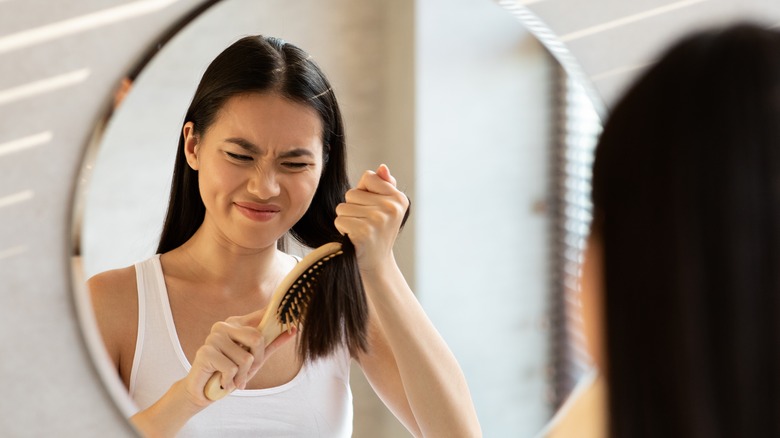Tricks For Detangling Fine Hair Without Causing Damage
Dealing with fine, long hair can sometimes feel as hard as climbing a mountain. Though the look is beautiful and the goal of many, it can be impossible to achieve even the simplest of hairstyles with long fine hair. It is easy for a cute ponytail or lengthy curls to turn into a tangled mess in a matter of minutes when the strands are fine.
Ripping through your hair with your brush just doesn't cut it anymore, now that we know the damage that all that force can bring to your hair. We're talking about big-time hair breakage. Hairstylist Kirsten Patterson tells Allure that "brushing knots out of wet hair can lead to major breakage," so it's best to prevent tangles as much as possible and use the correct techniques to remove any tangles that are inevitable. We're not talking about using the apple-smelling detangler your mom would use on you in the '90s either! Getting tangles out of your fine hair doesn't have to be painful or damaging anymore. If you are ready for your fine hair to be tangle free, long, and healthy, here are some detangling tricks backed by the experts.
Start in the shower
Let's start at the very beginning, as tangles are usually more likely to develop if you follow (or don't follow) certain processes while in the shower. Speaking to Byrdie, New York City hairstylist Devin Toth advises using shampoo "only on your scalp" while washing your hair. Meanwhile, "Be sure to brush or comb your conditioner all the way through your ends and then let it stay on for about a minute." This is better than trying to get knots out of bare wet hair. While in the shower, rinsing your hair with cold water rather than warm can also be beneficial, as heat can open the cuticle and strip the hair of its oils, leaving it dry and more susceptible to tangles, per Luxy Hair.
Use a detangler
After getting out of the shower, there is no way to ensure your hair will not become tangled again as it dries. Even if you choose to towel dry by patting your hair, the odds of your hair not tangling are slim to none. While mom's apple-scented version may not make the cut, a good detangler is still needed. "A detangler is a leave-in conditioner that contains a variety of oils for hair hydration," celebrity hairstylist Andrew Fitzsimons tells Good Housekeeping. A great detangler will make it easier to comb out tangles without all the hard ripping and tugging.
Start from the bottom
Start from the bottom, always. You should comb your hair starting at the ends and work your way up to the roots, per Healthline. The same goes for brushing your hair. Brushing or combing your hair from top to bottom compounds tangles at the ends of your hair, leaving you ripping through to get the tool out. When you brush small strands from bottom to top, you can remove your tool if needed and start again. Eventually, you will make it from top to bottom with no pulls. This technique will also help your hair to avoid falling flat after brushing.
Detangle often
One golden rule of tangle-free fine hair that most people unknowingly break is to detangle daily, if not more. Some people lightly brush over their hair but don't truly get the knots out. This will just make them worse! Gently detangle your hair with a comb every day to prevent tangles that are so serious they damage the hair. Brushing your hair at least once a day has other benefits too, such as helping hair shine, stimulating the scalp, and removing loose hairs (via Healthline). Even on days that you don't wash your hair, you should be ensuring that your hair is still brushed through thoroughly.
Be careful how you sleep
No matter if you are a rough sleeper or sleep like a baby at night, sleeping can cause tangles. Let's face it: Your hair is bound to rub onto the pillow, causing it to knot. Luckily, there are a few tricks to prevent your hair from tangling while you rest. If you are serious about preventing frizz, breakage, and tangles, sleeping on a silk pillowcase can be a great solution (via Bella All Natural). Silk helps reduce friction, which leads to knotting. Another option is to braid your hair before bed. Tangles come from your hair rubbing together during the night and a braid will keep your hair secure to prevent this friction without the tightness of other overnight hairstyles.





